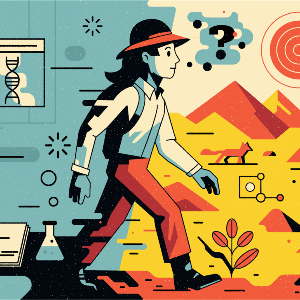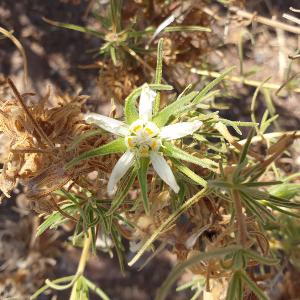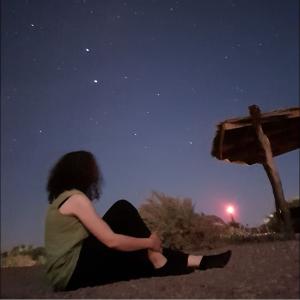From lecture hall… to the desert!
Field research in the driest desert in the world: doctoral candidate Julia Simonis recounts her journey to the Atacama.

Field research in the driest desert in the world: doctoral candidate Julia Simonis recounts her journey to the Atacama.

Crouching down among the gravel, which stretches all the way to the volcanoes on the horizon, I hack away at the desert soil. The sun is high in the sky, and the wind is just picking up. Quickly I tighten the little band under my chin so that my sunhat does not fly away. For two weeks now, I have been traveling in the Atacama Desert in Chile, one of the driest places on Earth. This morning we arrived in this area and got straight to work: recording GPS coordinates, measuring plants, collecting soil and plant samples.
3:07 | 25 Jul 2025 | ©LMU
I am doing my doctorate as part of the Collaborative Research Centre (CRC) 1211 “Earth – Evolution at the Dry Limit,” which is funded by the German Research Foundation (DFG). The researchers involved in this large-scale project travel every year to Chile to track the growth and development of plants in the desert over longer periods. This is my first time making the trip.

Huidobria chilensis survives under extreme heat and drought. | © Julia Simonis
I study desert plants from the Loasaceae family. What we humans view as “extreme conditions” and “environments hostile to life” are home for these unassuming plants, which brave the scorching heat and scarcity of water in the Atacama Desert. I plan to find out how they do this in the course of my doctoral research.
It is great that I can combine lab work and bio-informatics with genuine field research for my dissertation. Here I experience plants in their natural environment which I had previously known only as sample material in the lab. This complements my picture of the organisms I am researching.
University can be highly theoretical at times. Students generally learn from set scripts and often follow a strict protocol when doing experiments in the lab. Field work is very different. If something does not work, you have to be flexible. Here you are dealing with nature, not with the controlled, sterile conditions in the laboratory.
After I have packed away my latest samples, I turn to my provisions. For lunch today, as indeed every day, I am having white bread with avocado. As I chew on my bread, I take the time to enjoy the moment. Yes, it is hot and windy, the work is sometimes strenuous and repetitive, and the landscape is bare – but at the same, it is adventurous and beautiful. The desert is more various than you might think at first glance. If you look closely, you even learn to distinguish the many shades of brown of the rocks and the mountains.
It is impressive precisely because it is so utterly different to home in Munich. Certainly, there are some plants growing in the Atacama. But there are no woods, no meadows. In Germany, you do not notice the scent of fresh vegetation surrounding you. Only in the desert do you realize you miss it.
Although the Atacama is wide and rugged country, it is not a complete wilderness. There are well developed roads, power lines, and industry. This is because of the many mines, where resources such as copper and lithium are extracted. Offroad there is not a lot going on, but on the roads you encounter many trucks carrying things like sulfuric acid to the copper mines.

Group picture of the research team: (from left to right) Robin Schweikert, Julia Simonis, Prof. Dr. Julia Bechteler, Marianela Mariño, Eric Stein | © Dietmar Quandt
I had never been to Chile, never been to a desert. Now I know that not every desert consists of endless sand dunes – there are hardly any of those in the Atacama. And I learned that although water is a scarce resource here, it is very much present: in the mist that rises at night and forms a layer of dew on the cars in the morning. Another doctoral researcher from our team is studying Tillandsia – rootless plants that draw their water from the humid air.
I take some swigs out of my bottle and chat with Nela. I remark that on reflection, it was a bit excessive to pack 1.5 liters of sunscreen for the expedition. “We’re always wearing long clothing and hats anyway. Really I just need to put lotion on my lower arms when I roll up my sleeves.” Nela laughs: “Next year you’ll be wiser!”
I am glad that I get on so well with the others in the team. After all, we spend almost every minute together for more than three-and-a-half weeks, with few opportunities for time alone. As a rather introverted person, I was apprehensive about this for sure. Fortunately, I got to know the other team members in advance – Nela and I had even studied together. The plant biology unit consists of six people – five Germans and an Ecuadorian – from universities in Munich, Bonn, and Heidelberg.
Having a native Spanish speaker is of course extremely useful. Because I want to upgrade my language skills and Nela wants to improve her German, we teach other things during the long car journeys through the desert.
We travel quite a lot through the region, staying in the same place for three or four nights at a maximum – nomadism in the name of science. Tomorrow we are leaving for the next research site. Before then, we have to do a few more plants. So back to work.

The starry skies of the Atacama are legendary – at least if the moon doesn't happen to be full. | © Eric Stein
Most nights we stay in huts or other accommodation in the nearest city. However, the geographers with whom we are collaborating in the project regularly pitch camp in the field. When they offer me a free tent, I say yes without hesitation. A night under the stars in the Chilean outback? That is not an opportunity I want to pass up!
Because there is no extra sleeping bag for me, we gather up blankets, jackets, and towels and hope the night will not be too cold. As the sun goes down, I wait with anticipation for the night sky – the stars must be breathtaking here in the middle of nowhere. But my hopes are dashed by the full moon. Although that has its own charm, it is more of an obstacle when it comes to stargazing.
This night is one of the most intense moments of the entire journey. Luckily, the temperatures remain bearable. When I wake up the next morning, I see several desert foxes roaming among the tents. A frequent sight here, the foxes are very curious and not particularly shy.
At the end of the expedition, I am exhausted after a strenuous three-and-a-half weeks. In total, I have measured several hundred plants and collected various samples from around 100 plants. It feels strange that our close-knit group is now breaking up.
But I am looking forward to Munich, where everything is green and I will get some time for myself to recharge my social batteries. Also, I cannot wait to be back in the lab and work on the samples I collected. I will try to grow plants in the lab from the seeds I gathered in order to investigate how their gene expression changes under various conditions, depending on whether they have water or are under drought stress. In addition, I will be collaborating with geologists from the University of Cologne to study which elements the plants absorb from the soil and to what extent this influences their adaptation to desert conditions.
In a year’s time, I will be going back to Chile. I ask myself how ‘my’ plants will be doing by then. How much will they have grown? Will they even still be there? I do hope to see them again.
Julia Simonis is a PhD student in the research group of Julia Bechteler , Professor of Phylogenomics and Systematics of Plants and Fungi at LMU.
Read more articles from LMU's research magazine in the online section and never miss an issue by activating the magazine alert!